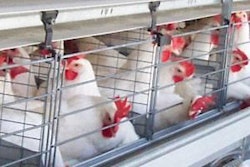
Sodexo Inc., the U.S. subsidiary of the multinational Sodexo based in France, has brought suit against the United Egg Producers and five major U.S. producers alleging collusion in pricing. The allegation is similar to the previous lawsuit that alleges that the UEP Certified Welfare Program, which reduced stocking density, was effectively a measure to reduce production and thereby increase selling prices.
The UEP functions according to the 1922 Capper-Volstead Act, which establishes the right for farms to organize as cooperatives for the purposes of joint marketing activities.
Sodexo, which purchased $250 million in eggs and egg products according to a January 11 article in the Los Angeles Times, maintains that the fact that UEP allows allied businesses to affiliate with the group disqualified the Capper-Volstead exemption and violated U.S. antitrust laws.
Motivation for the welfare program
The UEP Welfare Certification Program was introduced in 2002 following a prolonged period of review by scientific panel concerning trends and research in welfare, as influenced by EU developments. The allegations that the motivation for the welfare program was in fact production controlled is not borne out by facts. The table below shows that U.S. egg production, consumption and selling prices over the 2007 through 2011 period, which encompasses the 2008 price rise, was unconnected with the welfare program. It must be remembered that the stocking density requirements were phased in over five years to allow producers to expand by either re-caging or erecting new buildings.
During the period 2002 to 2008 it was evident that construction proceeded at a rate which compensated for decreased stocking density. A second consideration was that over the years in question there was considerable consolidation in the industry and many operations with obsolete housing and equipment either ceased production or were acquired by competitors who had sufficient resources to effect improvements.
Sodexo had sales of $7.2 billion in fiscal 2010 and generated $350 million in net profit. With 380,000 employees worldwide, Sodexo serves 50 million customers daily in 80 countries. The company provides food service to corporations, health care facilities, educational institutions and seniors. Sales in the U.S. in 2010 represented 40 % of total corporate revenue.
No resolution in near future
In addition to the UEP, co-defendants are Cal-Maine Foods, Hillandale Farms, Michael Foods, National Food Corporation and Ohio Fresh Eggs of Ohio and Rose Acre Farms.
A statement issued by the UEP legal counsel commented, “These lawsuits are an attack on United Egg Producers and its members and its animal welfare guidelines. Leading egg producers and the UEP faced with mounting concerns from their customers about the treatment of hens, realized the need to establish scientifically grounded industry standards for animal welfare. Because the guidelines provided for larger cage space for each laying hen, among other animal welfare requirements, plaintiffs claim the supply of eggs were reduced in a conspiracy to increase prices. Nothing could be further from the truth. UEP, its members and all defenders are vigorously defending these lawsuits.”
It is not anticipated that any resolution or settlement of this case will be forthcoming in the near future. In the similar previous action, which is pending Moark LLC, the subsidiary of Land O’ Lakes, reached a settlement with the plaintiffs. Legal costs will be considerable based on the magnitude of the claim.
It is too premature to anticipate whether any action will be taken by either the Federal Trade Commission or the Department of Justice. Although the Department of Justice and the Department of Agriculture jointly arranged a series of workshops in 2010 to examine the relationship between contractors and integrators and to determine whether monopolies existed in agricultural production, the emphasis was on beef, pork, dairy and broiler production. This is consistent with the structure of the egg industry in which there is less concentration of ownership and a lower proportion of contractor participation as with other livestock enterprises.
U.S. EGG PRODUCTION, CONSUMPTION AND PRICES 2000-2011
| Parameter | 2000 | 2005 | 2006 | 2007 | 2008 | 2009 | 2010 | 2011* |
| No. Eggs Produced Million dozen |
6,635 | 6,413 | 6,522 | 6,435 | 6,403 | 6,475 | 6,522 | 6,550 |
| Per capita Consumption | 257.3 | 255.8 | 257.8 | 250.1 | 248.9 | 247.7 | 246.6 | 245.6 |
| NY Price c/doz | 82.3 | 65.5 | 71.8 | 111.4 | 128.3 | 103.0 | 105.6 | 100.1 |
*projected


















